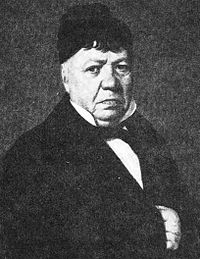
José de la Guerra. Portrait by Leonardo Barbieri (c.1856)
José Antonio de la Guerra y Noriega (March 6, 1779 – February 18, 1858) was a soldier and early settler of California.
Biography[]
José de la Guerra was born 1779 at Novales, Cantabria, Spain. As a boy he wished to be a war leader . When he was 13 De La Guerra went to Mexico City in Colonial Mexico, New Spain, to live with his maternal uncle Pedro Gonzales de Noriega, a wealthy merchant.
De La Guerra joined the frontier army in 1793, working for the paymaster general. He was appointed a cadet in 1798 at the Presidio of San Diego in Alta California. He was promoted to alférez (ensign) at the Presidio of Monterey in 1800, and was its acting Commandant in 1804. In 1806 he was made lieutenant at the Presidio of Santa Barbara. From 1807 to 1815 he was lieutenant at the Presidio of San Diego, and was, for a short time during 1806–1807 the commandant.
From 1815, De La Guerra served at Santa Barbara, becoming captain in 1817. He became Commandant in 1827, succeeding José Darío Argüello, who was promoted to Governor of Alta California. De La Guerra also became a Deputy (diputado) to the Mexican National Congress in 1827. De La Guerra served as Commandant until 1842, when he retired after 52 years of service in the army. De La Guerra was a Californio popularly known as El Capitán.
From land grants and purchases, De La Guerra became owner of over 1/2 million acres (2000 km²) in present Santa Barbara, Ventura, Marin, and Sacramento counties, California. These include Rancho Simi, Rancho Las Posas, Rancho San Julian, Rancho Los Alamos and Rancho El Conejo.
De La Guerra married María Antonia Carrillo (January 8, 1786 - December 26, 1843), daughter of José Raimundo Carrillo, on May 16, 1804. They had seven sons (Jose Antonio, Juan, Francisco, Pablo, Joaquin, Miguel, and Antonio Maria) and four daughters (Teresa, Angustias, Anita, and María Antonia).[1]
De La Guerra died in 1858 and is buried in the church crypt at Mission Santa Barbara with his wife. His house, called the Casa de la Guerra, still stands and is a historic landmark of downtown Santa Barbara.
Legacy[]
De La Guerra went down in Californian history as a father of the land and the Californios.
History of the De La Guerra Name[]
In the late 16th century during the time of the Moorish Wars in Spain, the last stronghold held by the Moors was Granada. The Spanish fortress in Granada was commanded by a commander whose name was "De La Vega". Don Juan De La Vega led a battle that led to the annihilation of the Moors and a complete reunification of Spain. Upon learning of this, King Ferdinand I summoned De La Vega to his court. De La Vega was at first reprimanded severely for starting his battle against the Moors on a Sunday, which was forbidden by Spanish law, and then the King had him kneel and knighted him. Thereupon, changing his name from "De La Vega" to "De La Guerra" ("Of The War").
See also[]
- Casa de la Guerra
- Pablo de la Guerra
- Antonio Maria de la Guerra
- Alfred Robinson - Anita de la Guerra de Noriega y Carrillo
- Ranchos of California
- List of Ranchos of California
Further reading[]
- Fr. Joseph A. Thompson. El Gran Capitan, José De la Guerra, (Franciscan Fathers of California, Cabrera & Sons, Los Angeles, 1961)
- De La Guerra Family Papers, Huntington Library, San Marino, California
- Narriative of daughter Teresa de La Guerra de Hartnell, 1875
- Dana, Richard Henry, Jr. "Two Years Before the Mast"
References[]
- ↑ De La Guerra Family Archived 2009-03-02 at the Wayback Machine.
The original article can be found at José de la Guerra y Noriega and the edit history here.